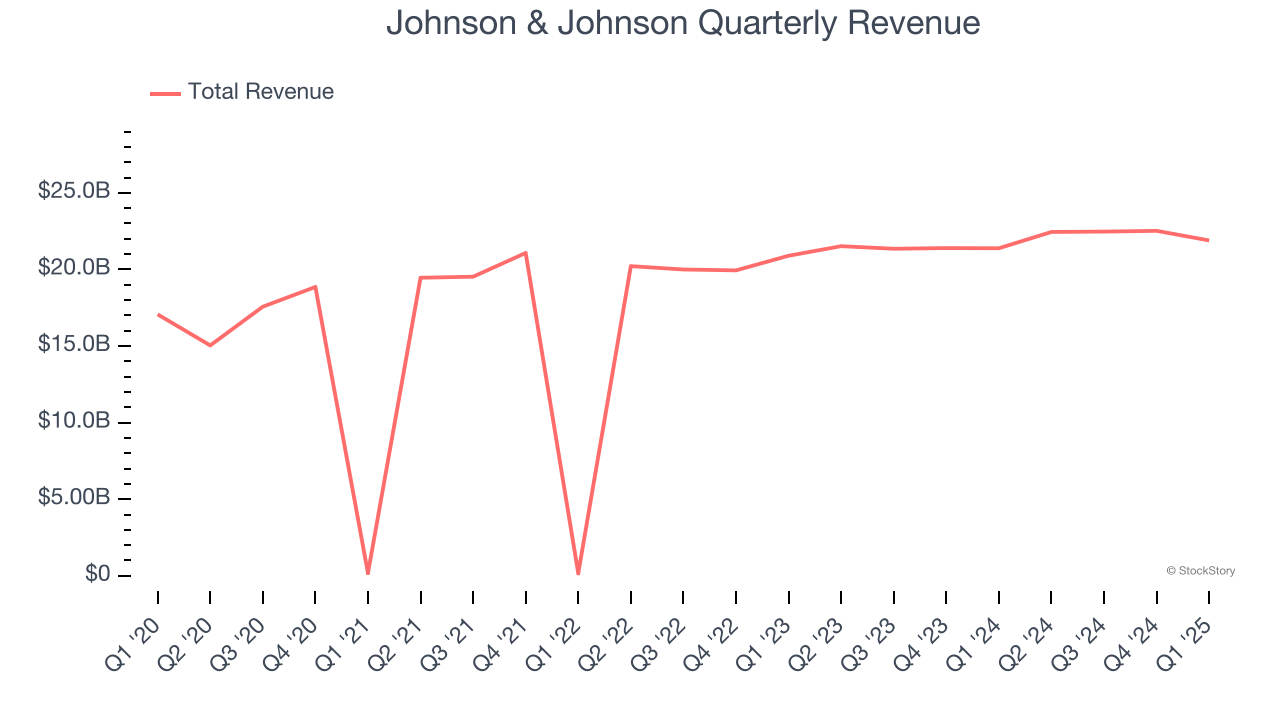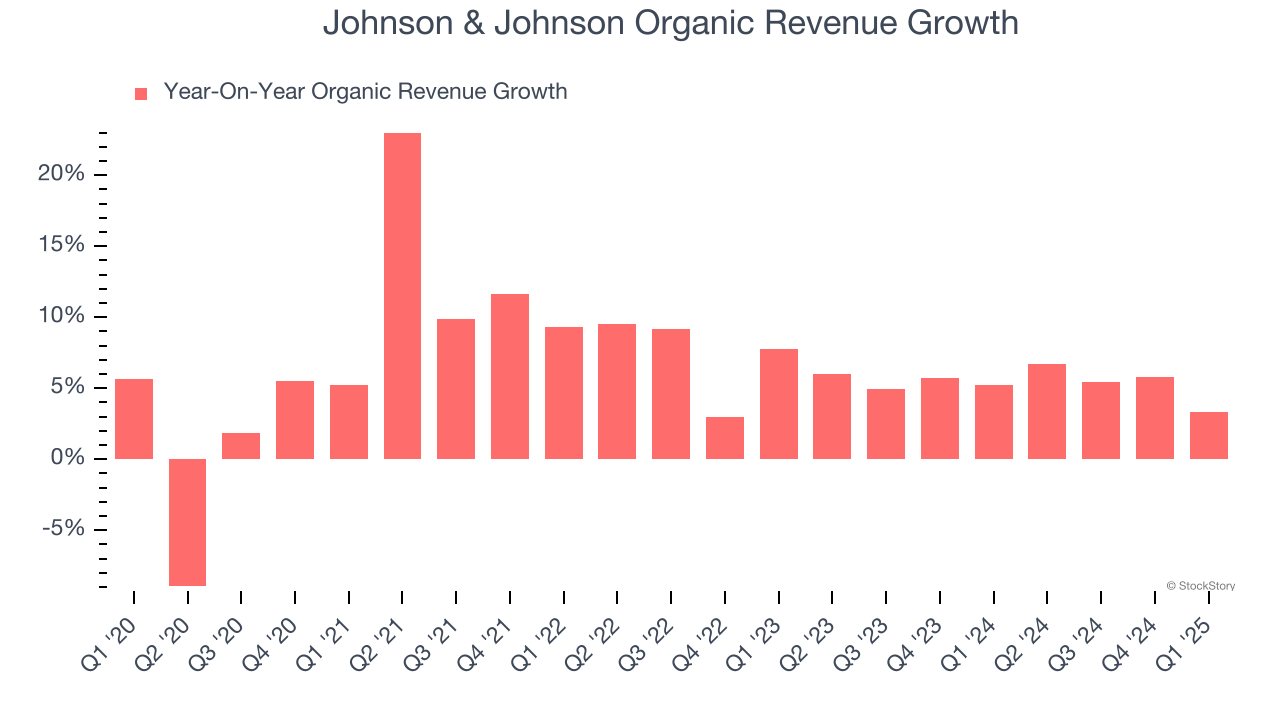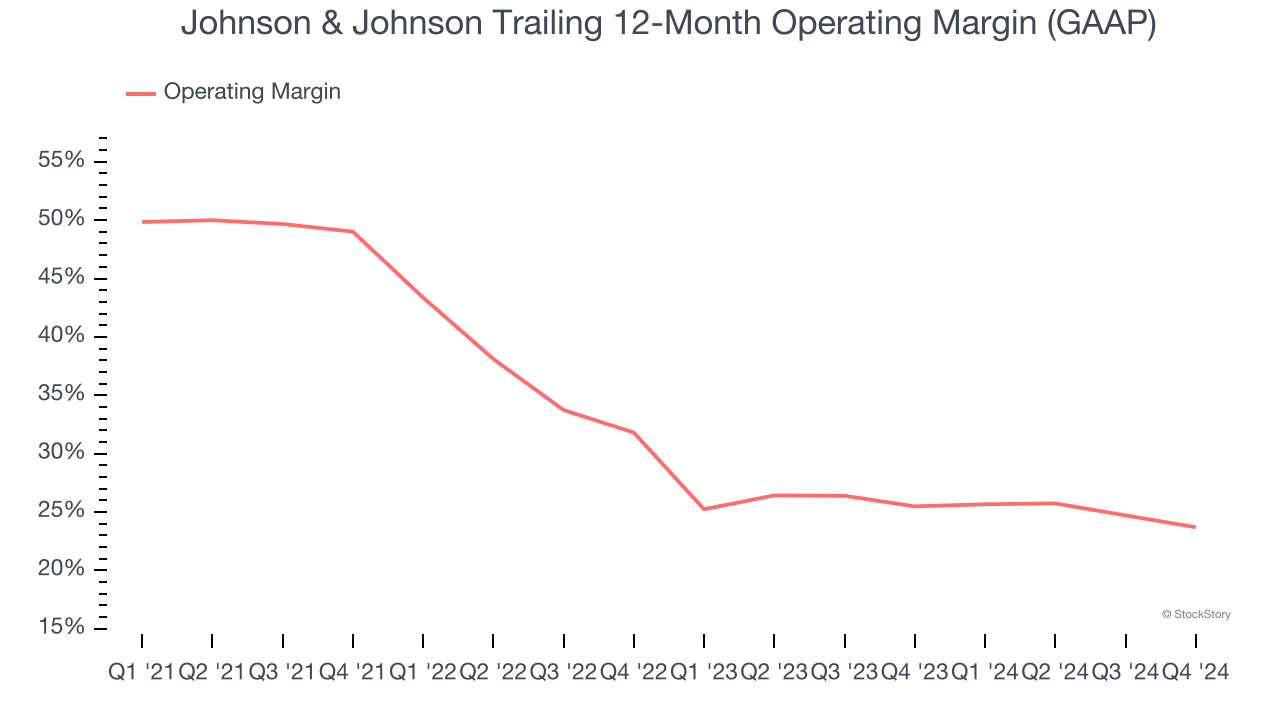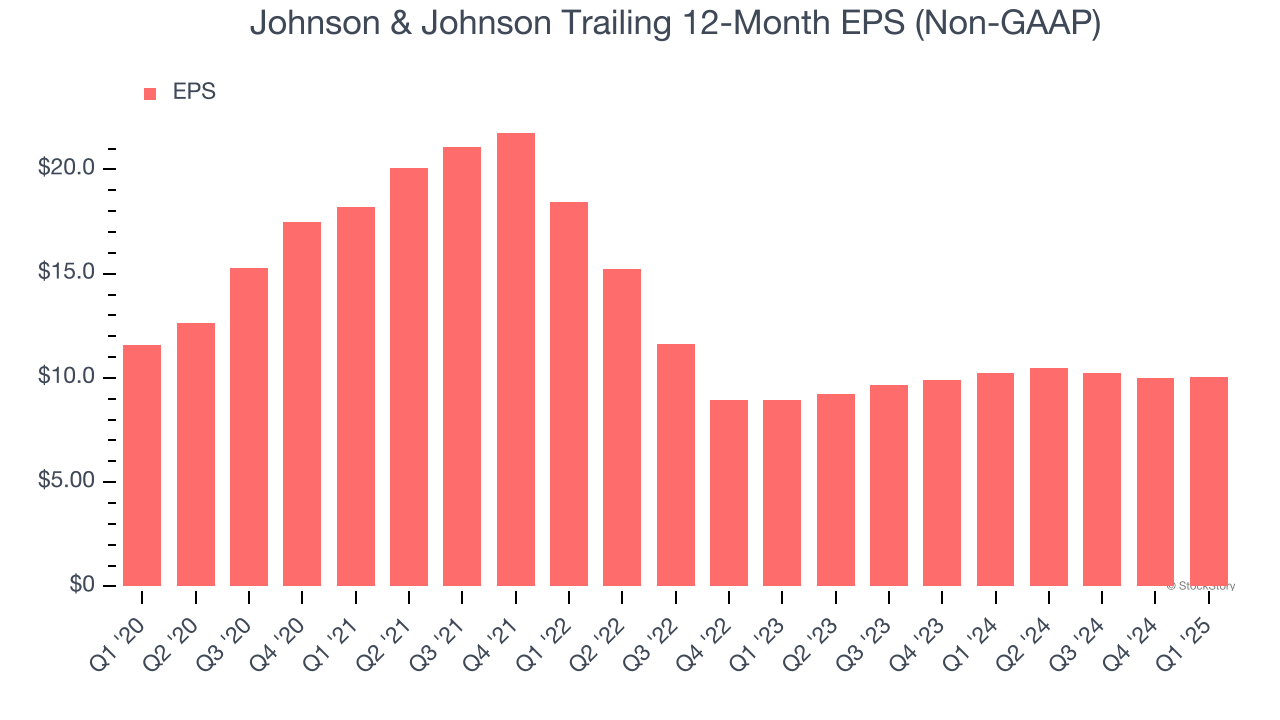
Multinational healthcare company Johnson & Johnson (NYSE:JNJ) reported Q1 CY2025 results beating Wall Street’s revenue expectations, with sales up 2.4% year on year to $21.89 billion. The company’s full-year revenue guidance of $92 billion at the midpoint came in 1.9% above analysts’ estimates. Its non-GAAP profit of $2.77 per share was 7.3% above analysts’ consensus estimates.
Is now the time to buy Johnson & Johnson? Find out by accessing our full research report, it’s free.
Johnson & Johnson (JNJ) Q1 CY2025 Highlights:
- Revenue: $21.89 billion vs analyst estimates of $21.56 billion (2.4% year-on-year growth, 1.5% beat)
- Adjusted EPS: $2.77 vs analyst estimates of $2.58 (7.3% beat)
- The company slightly lifted its revenue guidance for the full year to $92 billion at the midpoint from $91.3 billion
- Management reiterated its full-year Adjusted EPS guidance of $10.60 at the midpoint
- Organic Revenue rose 3.3% year on year (5.2% in the same quarter last year)
- Market Capitalization: $372 billion
NEW BRUNSWICK, N.J.--(BUSINESS WIRE)--Johnson & Johnson (NYSE: JNJ) today announced it has completed its acquisition of Intra-Cellular Therapies, Inc. Intra-Cellular Therapies is now part of Johnson & Johnson and will operate as a business unit within Johnson & Johnson Innovative Medicine. “At Johnson & Johnson, we are committed to transforming care for the millions of people worldwide living with neuropsychiatric and neurodegenerative disorders,” said Joaquin Duato, Chairman an...
Company Overview
Founded in 1886 and known for its iconic red cross logo, Johnson & Johnson (NYSE:JNJ) is a global healthcare company that develops and sells pharmaceuticals, medical devices, and technologies focused on human health and well-being.
Branded Pharmaceuticals
The branded pharmaceutical industry relies on a high-cost, high-reward business model, driven by substantial investments in research and development to create innovative, patent-protected drugs. Successful products can generate significant revenue streams over their patent life, and the larger a roster of drugs, the stronger a moat a company enjoys. However, the business model is inherently risky, with high failure rates during clinical trials, lengthy regulatory approval processes, and intense competition from generic and biosimilar manufacturers once patents expire. These challenges, combined with scrutiny over drug pricing, create a complex operating environment. Looking ahead, the industry is positioned for tailwinds from advancements in precision medicine, increasing adoption of AI to enhance drug development efficiency, and growing global demand for treatments addressing chronic and rare diseases. However, headwinds include heightened regulatory scrutiny, pricing pressures from governments and insurers, and the looming patent cliffs for key blockbuster drugs. Patent cliffs bring about competition from generics, forcing branded pharmaceutical companies back to the drawing board to find the next big thing.
Sales Growth
A company’s long-term sales performance can indicate its overall quality. Any business can put up a good quarter or two, but the best consistently grow over the long haul. Over the last five years, Johnson & Johnson grew its sales at a mediocre 5.4% compounded annual growth rate. This wasn’t a great result compared to the rest of the healthcare sector, but there are still things to like about Johnson & Johnson.

Long-term growth is the most important, but within healthcare, a half-decade historical view may miss new innovations or demand cycles. Johnson & Johnson’s annualized revenue growth of 5% over the last two years aligns with its five-year trend, suggesting its demand was consistently weak.
Johnson & Johnson also reports organic revenue, which strips out one-time events like acquisitions and currency fluctuations that don’t accurately reflect its fundamentals. Over the last two years, Johnson & Johnson’s organic revenue averaged 5.4% year-on-year growth. Because this number aligns with its normal revenue growth, we can see the company’s core operations (not acquisitions and divestitures) drove most of its results.

This quarter, Johnson & Johnson reported modest year-on-year revenue growth of 2.4% but beat Wall Street’s estimates by 1.5%.
Looking ahead, sell-side analysts expect revenue to grow 2.1% over the next 12 months, a slight deceleration versus the last two years. This projection is underwhelming and indicates its products and services will face some demand challenges. At least the company is tracking well in other measures of financial health.
Today’s young investors won’t have read the timeless lessons in Gorilla Game: Picking Winners In High Technology because it was written more than 20 years ago when Microsoft and Apple were first establishing their supremacy. But if we apply the same principles, then enterprise software stocks leveraging their own generative AI capabilities may well be the Gorillas of the future. So, in that spirit, we are excited to present our Special Free Report on a profitable, fast-growing enterprise software stock that is already riding the automation wave and looking to catch the generative AI next.
Operating Margin
Operating margin is one of the best measures of profitability because it tells us how much money a company takes home after subtracting all core expenses, like marketing and R&D.
Johnson & Johnson has been a well-oiled machine over the last five years. It demonstrated elite profitability for a healthcare business, boasting an average operating margin of 31.6%.
Analyzing the trend in its profitability, Johnson & Johnson’s operating margin decreased by 12.4 percentage points over the last five years. The company’s two-year trajectory also shows it failed to get its profitability back to the peak as its margin fell by 2.2 percentage points. This performance was poor no matter how you look at it - it shows its expenses were rising and it couldn’t pass those costs onto its customers.

in line with the same quarter last year. This indicates the company’s overall cost structure has been relatively stable.
Earnings Per Share
Revenue trends explain a company’s historical growth, but the long-term change in earnings per share (EPS) points to the profitability of that growth – for example, a company could inflate its sales through excessive spending on advertising and promotions.
Sadly for Johnson & Johnson, its EPS declined by 2.8% annually over the last five years while its revenue grew by 5.4%. This tells us the company became less profitable on a per-share basis as it expanded due to non-fundamental factors such as interest expenses and taxes.

Diving into the nuances of Johnson & Johnson’s earnings can give us a better understanding of its performance. As we mentioned earlier, Johnson & Johnson’s operating margin declined by 12.4 percentage points over the last five years. This was the most relevant factor (aside from the revenue impact) behind its lower earnings; taxes and interest expenses can also affect EPS but don’t tell us as much about a company’s fundamentals.
In Q1, Johnson & Johnson reported EPS at $2.77, up from $2.71 in the same quarter last year. This print beat analysts’ estimates by 7.3%. Over the next 12 months, Wall Street expects Johnson & Johnson’s full-year EPS of $10.05 to grow 3.9%.
Key Takeaways from Johnson & Johnson’s Q1 Results
We enjoyed seeing Johnson & Johnson beat analysts’ organic revenue expectations this quarter. We were also glad its full-year revenue guidance exceeded Wall Street’s estimates. Lastly, the company reiterated full-year EPS guidance which is always comforting. Overall, we think this was a decent quarter with some key metrics above expectations. The stock remained flat at $155.89 immediately after reporting.
Johnson & Johnson put up rock-solid earnings, but one quarter doesn’t necessarily make the stock a buy. Let’s see if this is a good investment. When making that decision, it’s important to consider its valuation, business qualities, as well as what has happened in the latest quarter. We cover that in our actionable full research report which you can read here, it’s free.
